Mechanical Response of CNT/2024Al Composite to Compression and Tension at Different Strain Rates
Abstract
1. Introduction
2. Materials and Methods
2.1. Materials
2.2. Dynamic and Quasi-Static Compression
2.3. Quasi-Static Tension
3. Results and Discussion
3.1. Compression Stress–Strain Curves
3.2. Compression Fracture Analysis
3.3. Tensile Loading and Strain Field Mapping
4. Conclusions
Supplementary Materials
Author Contributions
Funding
Data Availability Statement
Conflicts of Interest
References
- Miracle, D. Metal matrix composites–from science to technological significance. Compos. Sci. Technol. 2005, 65, 2526–2540. [Google Scholar] [CrossRef]
- Geng, J.W.; Liu, G.; Wang, F.F.; Hong, T.R.; Xia, C.J.; Wang, M.L.; Chen, D.; Ma, N.H.; Wang, H.W. Microstructural and mechanical anisotropy of extruded in-situ TiB2/2024 composite plate. Mater. Sci. Eng. A 2017, 687, 131–140. [Google Scholar] [CrossRef]
- Chen, B.; Shen, J.; Ye, X.; Imai, H.; Umeda, J.; Takahashi, M.; Kondoh, K. Solid-state interfacial reaction and load transfer efficiency in carbon nanotubes (CNTs)-reinforced aluminum matrix composites. Carbon 2017, 114, 198–208. [Google Scholar] [CrossRef]
- Zhang, L.; Wang, Z.; Li, Q.G.; Wu, J.Y.; Shi, G.P.; Qi, F.F.; Zhou, X. Microtopography and mechanical properties of vacuum hot pressing Al/B4C composites. Ceram. Int. 2018, 44, 3048–3055. [Google Scholar] [CrossRef]
- Cheng, J.C.; Chai, H.W.; Fan, G.L.; Li, Z.Q.; Xie, H.L.; Tan, Z.Q.; Bie, B.X.; Huang, J.Y.; Luo, S.N. Anisotropic spall behavior of CNT/2024Al composites under plate impact. Carbon 2020, 170, 589–599. [Google Scholar] [CrossRef]
- Xie, K.; Zhang, G.P.; Huang, H.; Zhang, J.J.; Liu, Z.X.; Cai, B. Investigation of the main strengthening mechanism of carbon nanotube reinforced aluminum composites. Mater. Sci. Eng. A 2021, 804, 140780. [Google Scholar] [CrossRef]
- Liu, Z.; Xiao, B.; Wang, W.; Ma, Z. Singly dispersed carbon nanotube/aluminum composites fabricated by powder metallurgy combined with friction stir processing. Carbon 2012, 50, 1843–1852. [Google Scholar] [CrossRef]
- Choi, H.; Shin, J.; Min, B.; Park, J.; Bae, D. Reinforcing effects of carbon nanotubes in structural aluminum matrix nanocomposites. J. Mater. Res. 2009, 24, 2610–2616. [Google Scholar] [CrossRef]
- Fu, X.W.; Tan, Z.Q.; Ma, Z.Q.; Li, Z.; Fan, G.L.; Xiong, D.B.; Li, Z.Q. Powder assembly & alloying to CNT/Al–Cu–Mg composites with trimodal grain structure and strength-ductility synergy. Compos. Part B Eng. 2021, 225, 109271. [Google Scholar]
- Shin, S.E.; Bae, D.H. Strengthening behavior of chopped multi-walled carbon nanotube reinforced aluminum matrix composites. Mater. Char. 2013, 83, 170–177. [Google Scholar] [CrossRef]
- Mokdad, F.; Chen, D.L.; Liu, Z.Y.; Xiao, B.L.; Ni, D.R.; Ma, Z.Y. Deformation and strengthening mechanisms of a carbon nanotube reinforced aluminum composite. Carbon 2016, 104, 64–77. [Google Scholar] [CrossRef]
- Wang, M.J.; Shen, J.H.; Chen, B.; Wang, Y.F.; Umeda, J.; Kondoh, K.; Li, Y.L. Compressive behavior of CNT-reinforced aluminum matrix composites under various strain rates and temperatures. Ceram. Int. 2022, 48, 10299–10310. [Google Scholar] [CrossRef]
- Pérez-Bustamante, R.; Pérez-Bustamante, F.; Estrada-Guel, I.; Santillán-Rodríguez, C.R.; Matutes-Aquino, J.A.; Herrera-Ramírez, J.M.; Miki-Yoshida, M.; Martínez-Sánchez, R. Characterization of Al2024-CNTs composites produced by mechanical alloying. Powder Tech. 2011, 212, 390–396. [Google Scholar] [CrossRef]
- Ma, Y.; Zhou, X.; Thompson, G.E.; Hashimoto, T.; Thomson, P.; Fowles, M. Distribution of intermetallics in an AA 2099-T8 aluminium alloy extrusion. Mater. Chem. Phys. 2011, 126, 46–53. [Google Scholar] [CrossRef]
- Liu, Z.Y.; Xiao, B.L.; Wang, W.G.; Ma, Z.Y. Effect of carbon nanotube orientation on mechanical properties and thermal expansion coefficient of carbon nanotube-reinforced aluminum matrix composites. Acta Metall. Sin. 2014, 27, 901–908. [Google Scholar] [CrossRef]
- Engler, O.; Aegerter, J. Texture and anisotropy in the Al–Mg alloy AA 5005–Part II: Correlation of texture and anisotropic properties. Mater. Sci. Eng. A 2014, 618, 663–671. [Google Scholar] [CrossRef]
- Tajally, M.; Emadoddin, E. Mechanical and anisotropic behaviors of 7075 aluminum alloy sheets. Mater. Des. 2011, 32, 1594–1599. [Google Scholar] [CrossRef]
- Wang, M.; Li, Y.; Chen, B.; Shi, D.; Umeda, J.; Kondoh, K.; Shen, J. The rate-dependent mechanical behavior of CNT-reinforced aluminum matrix composites under tensile loading. Mater. Sci. Eng. A 2021, 808, 140893. [Google Scholar] [CrossRef]
- Jiang, T.Z.; Xue, P.; Butt, H.S.U. Pulse shaper design for dynamic testing of viscoelastic materials using polymeric SHPB. Int. J. Impact Eng. 2015, 79, 45–52. [Google Scholar] [CrossRef]
- Kolsky, H. Stress Waves in Solids; Dover Publications: Mineola, NY, USA, 1963; Volume 1098. [Google Scholar]
- Yang, J.; Li, S.K.; Luo, Y.M.; Yan, L.L.; Wang, F.C. Compressive properties and fracture behavior of ceramic fiber-reinforced carbon aerogel under quasi-static and dynamic loading. Carbon 2011, 49, 1542–1549. [Google Scholar] [CrossRef]
- Wu, S.Y.; Bie, B.X.; Fan, D.; Sun, T.; Fezzaa, K.; Feng, Z.D.; Huang, J.Y.; Luo, S.N. Dynamic shear localization of a titanium alloy under high-rate tension characterized by x-ray digital image correlation. Mater. Charact. 2018, 137, 58–66. [Google Scholar] [CrossRef]
- Lecompte, D.; Smits, A.; Bossuyt, S.; Sol, H.; Vantomme, J.; Hemelrijck, D.V.; Habraken, A.M. Quality assessment of speckle patterns for digital image correlation. Opt. Laser. Eng. 2006, 44, 1132–1145. [Google Scholar] [CrossRef]
- Guden, M.; Hall, I.W. Dynamic properties of metal matrix composites: A comparative study. Mater. Sci. Eng. A 1998, 242, 141–152. [Google Scholar] [CrossRef]
- Xu, R.; Tan, Z.Q.; Fan, G.L.; Ji, G.; Xiong, D.B.; Guo, Q.; Su, Y.S.; Li, Z.Q.; Zhang, D. High-strength CNT/Al-Zn-Mg-Cu composites with improved ductility achieved by flake powder metallurgy via elemental alloying. Compos. Part A Appl. 2018, 111, 1–11. [Google Scholar] [CrossRef]
- Gurusideswar, S.; Velmurugan, R.; Gupta, N.K. Study of rate dependent behavior of glass/epoxy composites with nanofillers using non-contact strain measurement. Int. J. Impact Eng. 2017, 110, 324–337. [Google Scholar] [CrossRef]
- Ling, Z.; Luo, L.; Dodd, B. Experimental study on the formation of shear bands and effect of microstructure in Al-2124/SiCp composites under dynamic compression. J. Phys. IV 1994, 4, C8-453–C8-458. [Google Scholar]
- Tan, Z.H.; Pang, B.J.; Qin, D.T.; Shi, J.Y.; Gai, B.Z. The compressive properties of 2024Al matrix composites reinforced with high content SiC particles at various strain rates. Mater. Sci. Eng. A 2008, 489, 302–309. [Google Scholar] [CrossRef]
- Ye, S.J.; Bie, B.X.; Zhang, Z.M.; Zhao, X.J.; Sun, T.; Fezzaa, K.; Huang, J.Y.; Yao, X.H.; Luo, S.N. Rate-dependent strength and deformation heterogeneity of B4C-reinforced Al composite: Time-resolved imaging with synchrotron X-rays. Ceram. Int. 2021, 47, 16141–16151. [Google Scholar] [CrossRef]
- Duan, B.; Zhou, Y.; Wang, D.Z.; Zhao, Y.R. Effect of CNTs content on the microstructures and properties of CNTs/Cu composite by microwave sintering. J. Alloys Compd. 2019, 771, 498–504. [Google Scholar] [CrossRef]
- Lu, L.; Fan, D.; Bie, B.X.; Ran, X.X.; Qi, M.L.; Parab, N.; Sun, J.Z.; Liao, H.J.; Hudspeth, M.C.; Claus, B.; et al. Note: Dynamic strain field mapping with synchrotron X-ray digital image correlation. Rev. Sci. Instrum 2014, 85, 076101. [Google Scholar] [CrossRef]
- Bie, B.X.; Huang, J.Y.; Su, B.; Lu, L.; Fan, D.; Sun, T.; Fezzaa, K.; Qi, M.L.; Luo, S.N. Dynamic tensile deformation and damage of B4C-reinforced Al composites: Time-resolved imaging with synchrotron x-rays. Mater. Sci. Eng. A 2016, 664, 86–93. [Google Scholar] [CrossRef]
- Huang, J.Y.; Lu, L.; Fan, D.; Sun, T.; Fezzaa, K.; Xu, S.L.; Zhu, M.H.; Luo, S.N. Heterogeneity in deformation of granular ceramics under dynamic loading. Scripta Mater. 2016, 111C, 114–118. [Google Scholar] [CrossRef]
- Prentice, H.J.; Proud, W.G.; Walley, S.M.; Field, J.E. The use of digital speckle radiography to study the ballistic deformation of a polymer bonded sugar (an explosive simulant). Int. J. Impact Eng. 2010, 37, 1113–1120. [Google Scholar] [CrossRef]
- Currey, J.D. Mechanical properties of mother of pearl in tension. Proc. R. Soc. Lond. B 1977, 196, 443–463. [Google Scholar]
- Sun, J.Y.; Bhushan, B. Hierarchical structure and mechanical properties of nacre: A review. RSC Adv. 2012, 2, 7617–7632. [Google Scholar] [CrossRef]
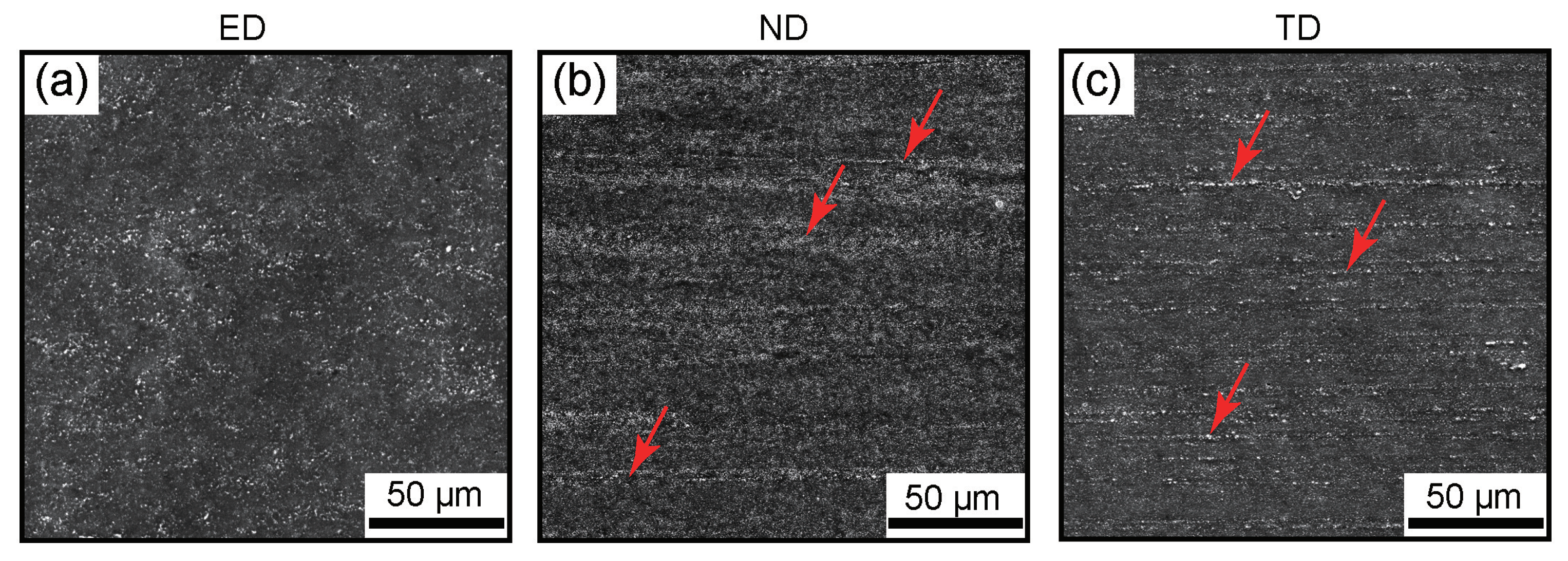

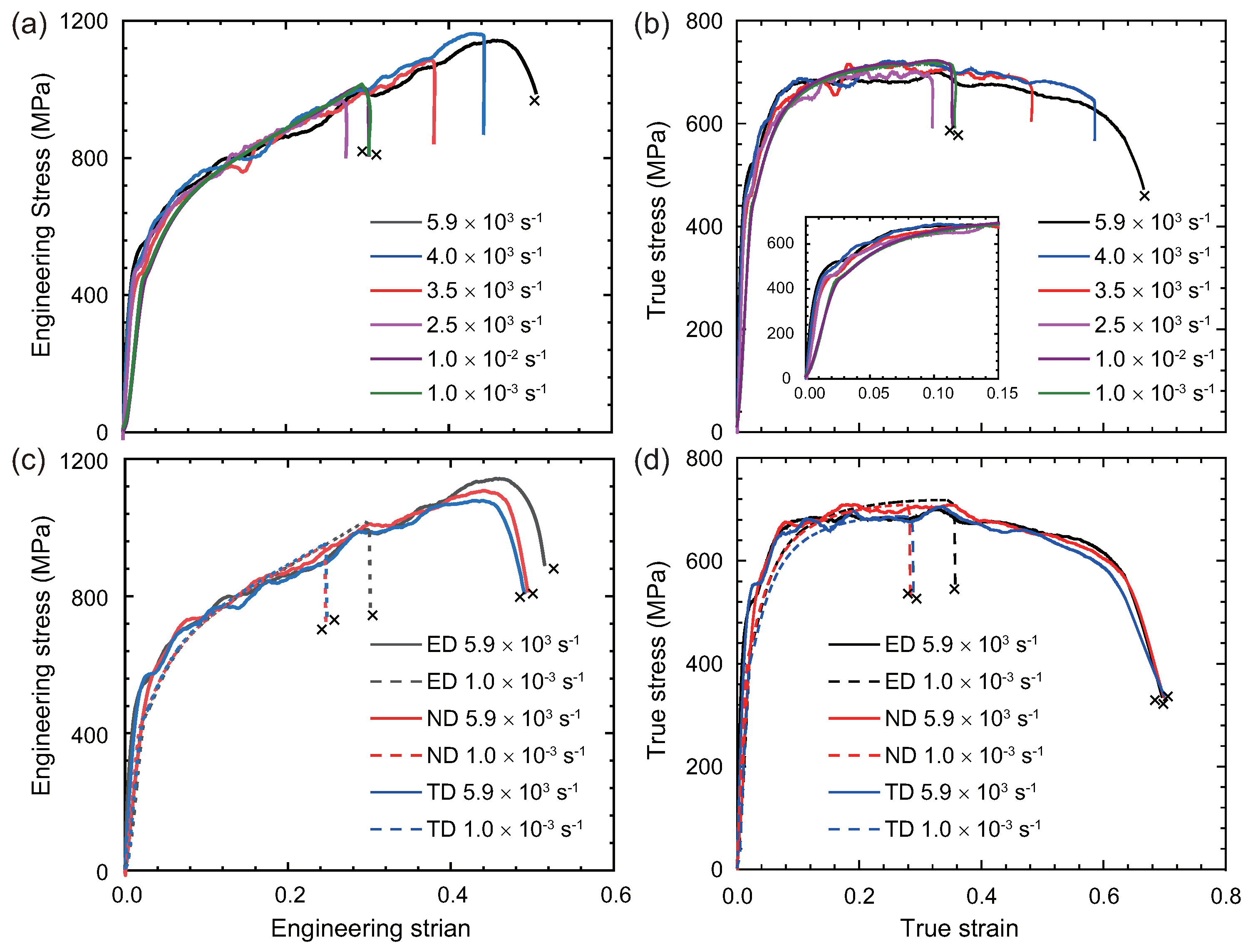

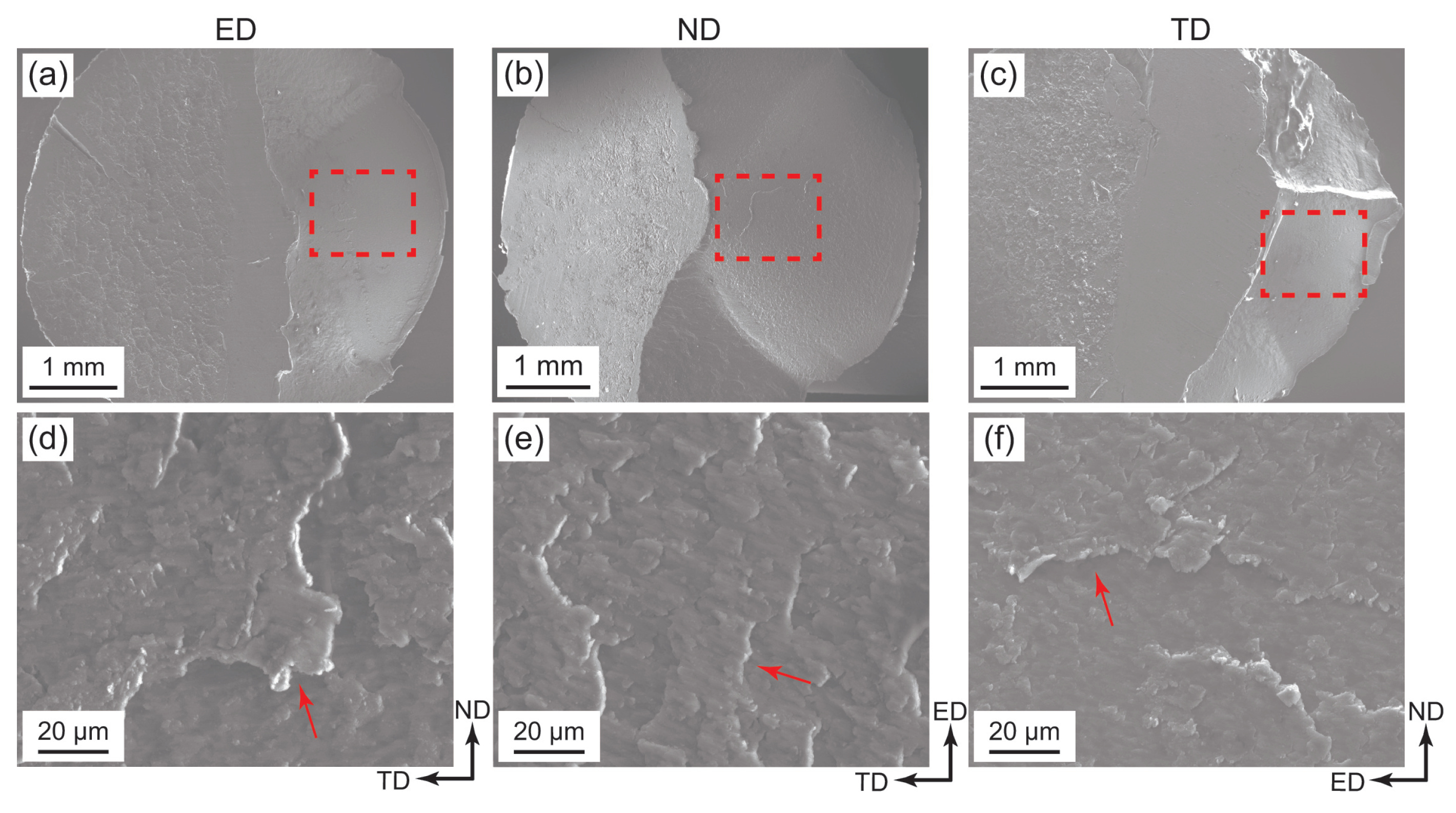
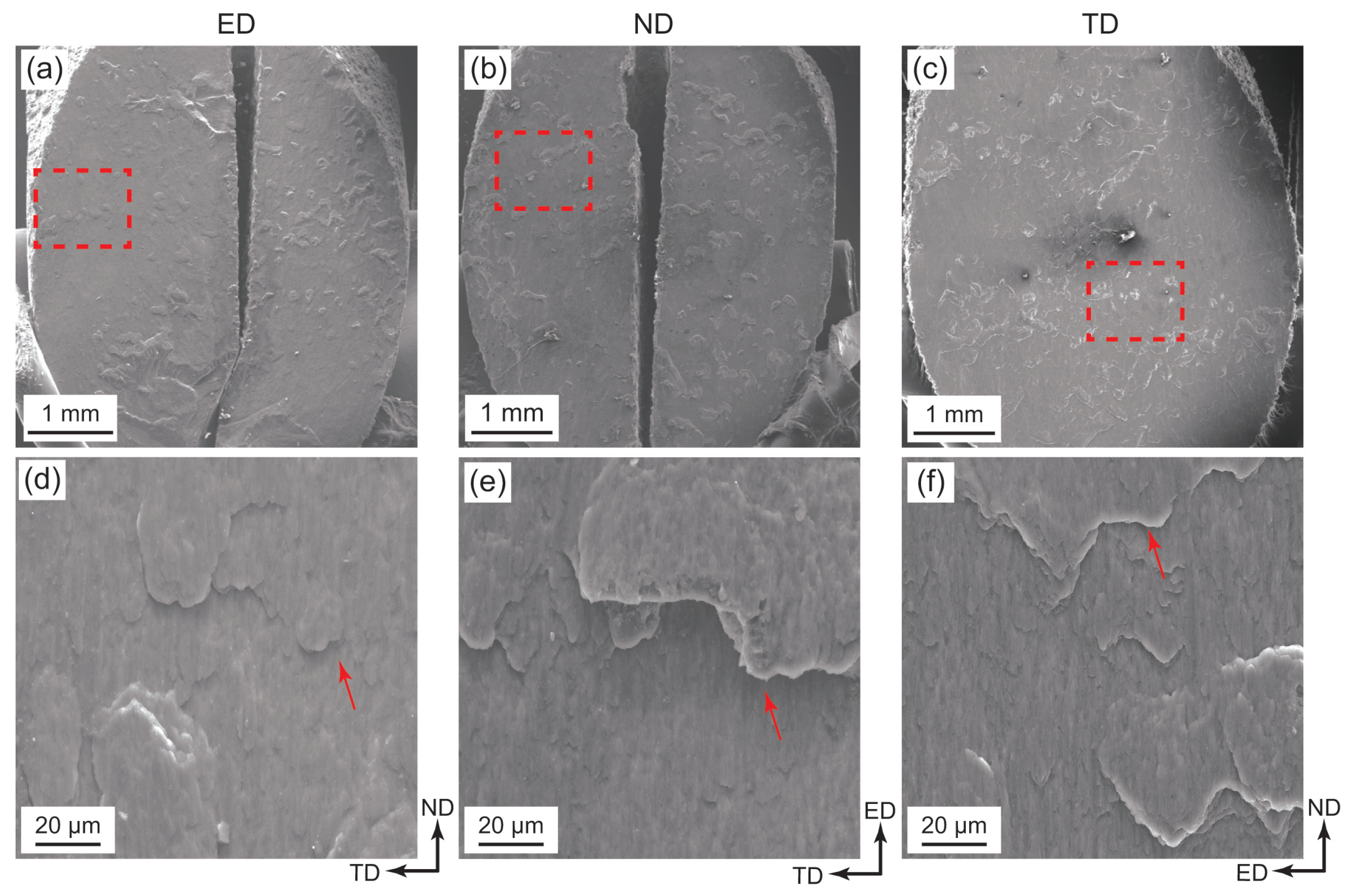
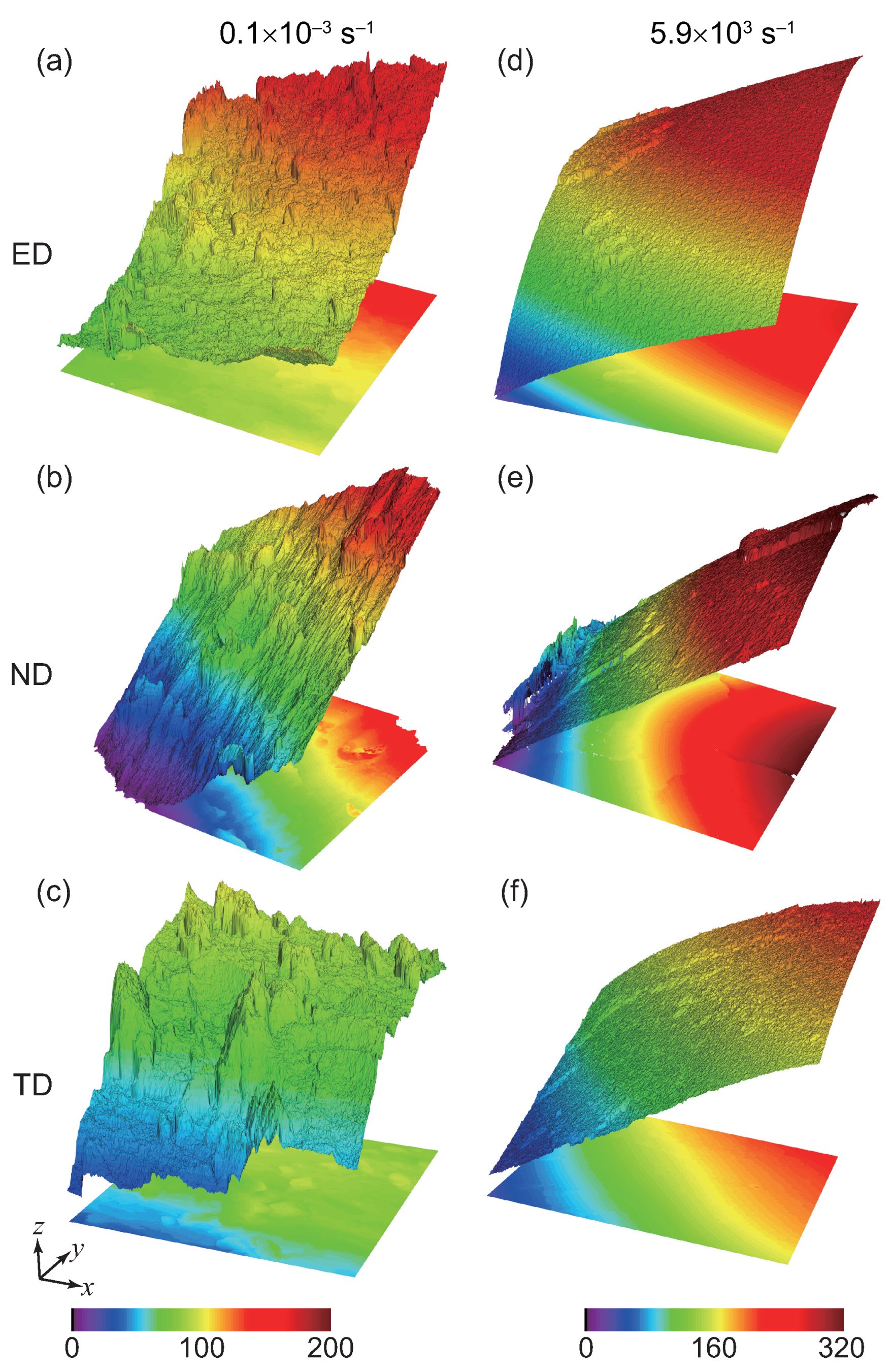
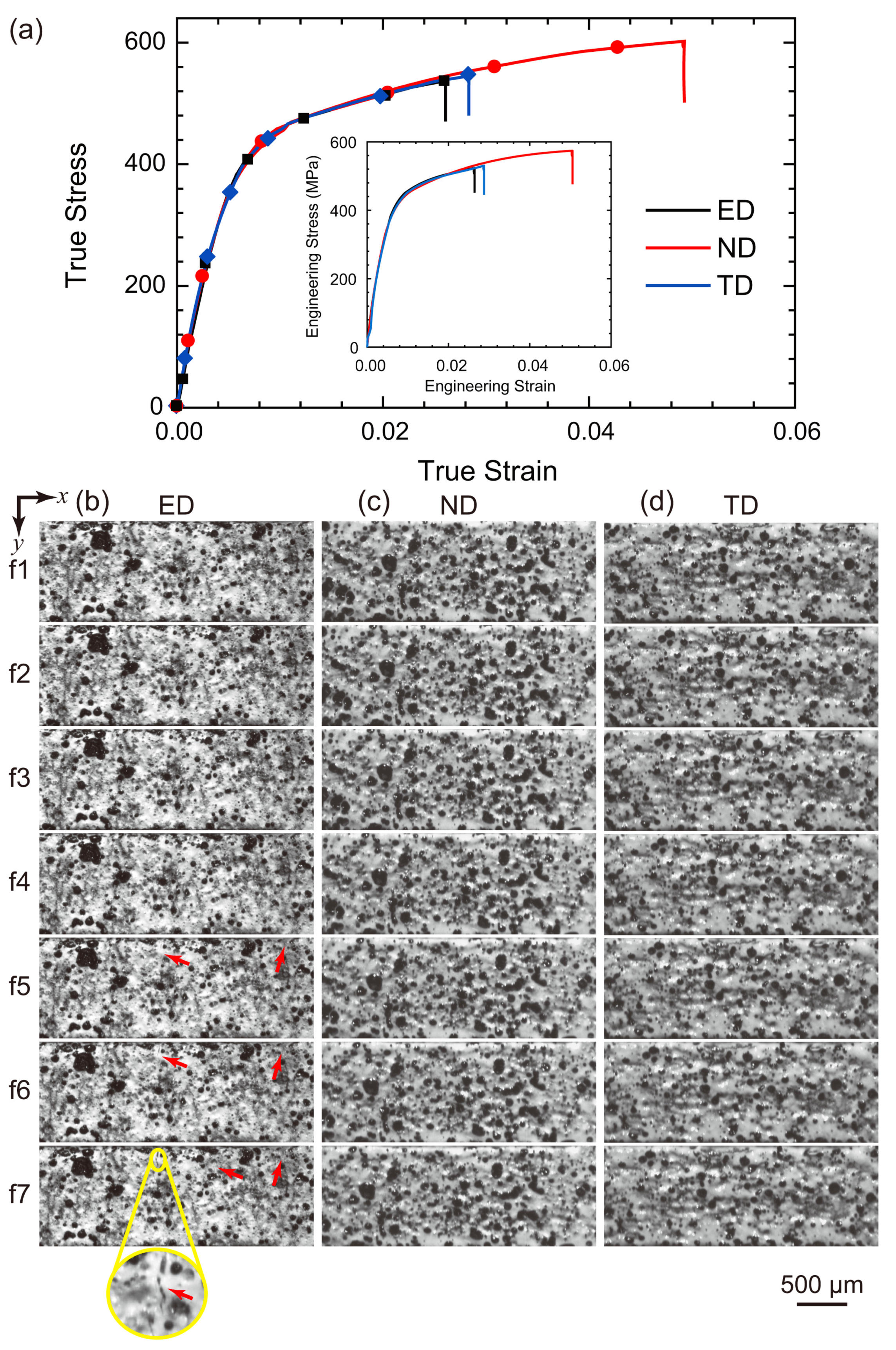
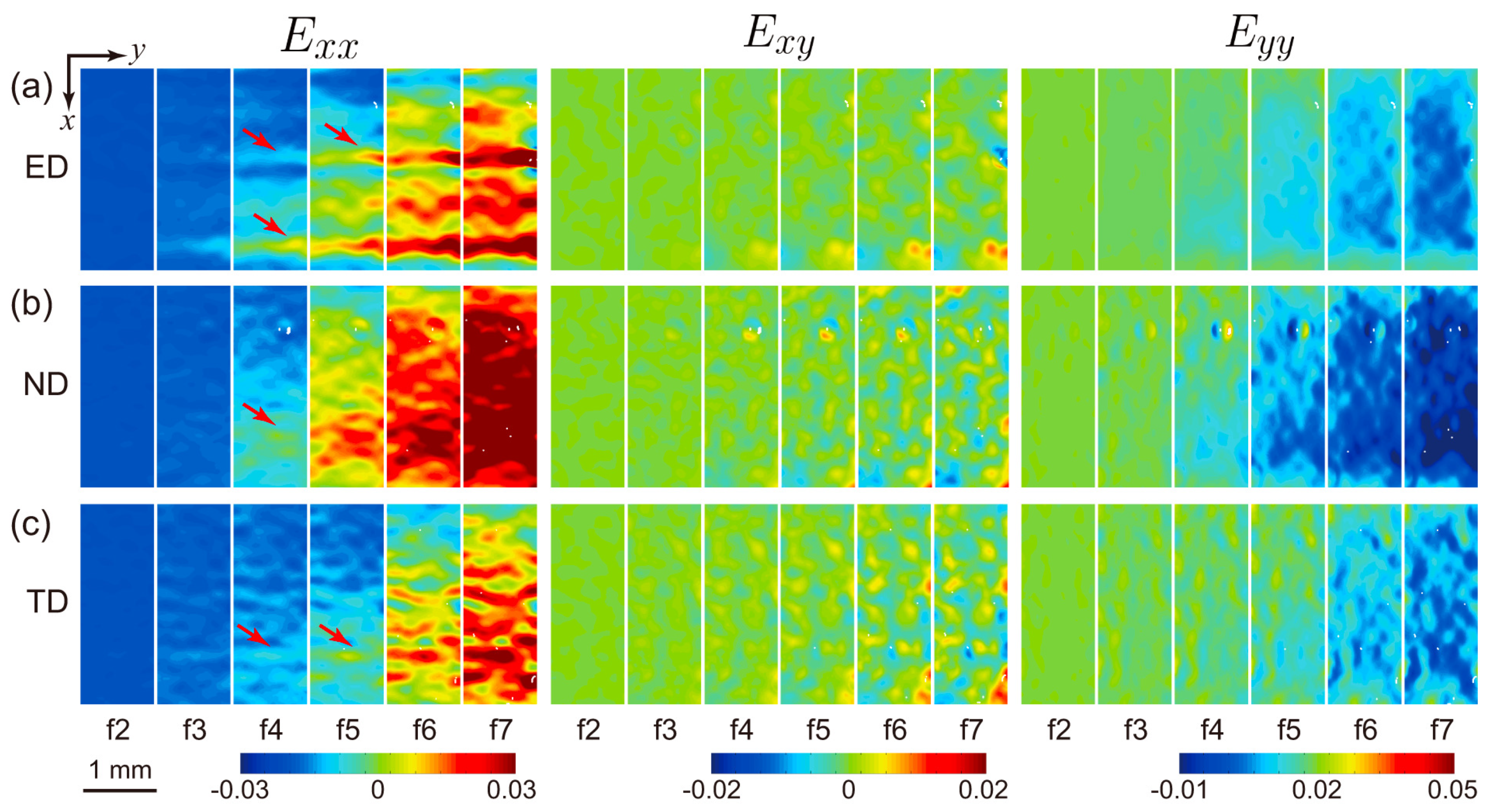
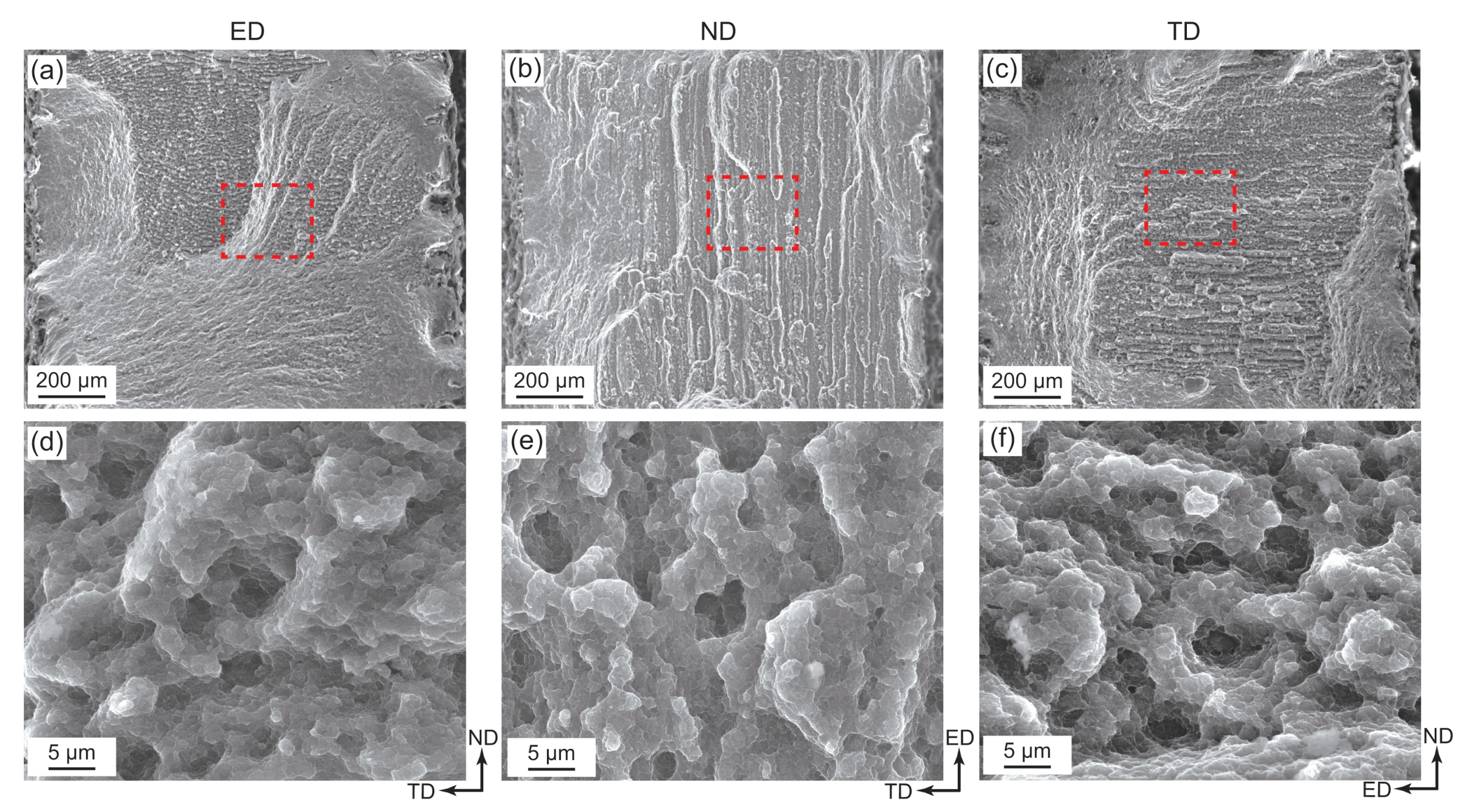
| Shot # | Loading Direction | Loading Method | Strain Rate (s) | Yield Strength (MPa) | Fracture Strain | Fracture Strength (MPa) |
|---|---|---|---|---|---|---|
| 1 | ED | MTS | 0.001 | 441.722 | 0.349 | 716.116 |
| 2 | ED | MTS | 0.01 | 441.917 | 0.344 | 719.161 |
| 3 | ED | SHPB | 2500 | 453.943 | – | – |
| 4 | ED | SHPB | 3500 | 460.910 | – | – |
| 5 | ED | SHPB | 4000 | 471.581 | – | – |
| 6 | ED | SHPB | 5900 | 486.605 | 0.614 | 604.560 |
| 7 | ND | MTS | 0.001 | 418.839 | 0.279 | 707.353 |
| 8 | ND | SHPB | 5900 | 519.886 | 0.629 | 579.603 |
| 9 | TD | MTS | 0.001 | 405.094 | 0.279 | 685.200 |
| 10 | TD | SHPB | 5900 | 527.843 | 0.594 | 592.755 |
| 11 | ND | MTS-stretch | 0.001 | 357.728 | 0.049 | 602.221 |
| 12 | ED | MTS-stretch | 0.001 | 365.712 | 0.026 | 537.149 |
| 13 | TD | MTS-stretch | 0.001 | 362.627 | 0.028 | 545.542 |
Disclaimer/Publisher’s Note: The statements, opinions and data contained in all publications are solely those of the individual author(s) and contributor(s) and not of MDPI and/or the editor(s). MDPI and/or the editor(s) disclaim responsibility for any injury to people or property resulting from any ideas, methods, instructions or products referred to in the content. |
© 2023 by the authors. Licensee MDPI, Basel, Switzerland. This article is an open access article distributed under the terms and conditions of the Creative Commons Attribution (CC BY) license (https://creativecommons.org/licenses/by/4.0/).
Share and Cite
Xiang, J.; Zheng, Y.; Li, J.; Tan, Z. Mechanical Response of CNT/2024Al Composite to Compression and Tension at Different Strain Rates. Metals 2023, 13, 254. https://doi.org/10.3390/met13020254
Xiang J, Zheng Y, Li J, Tan Z. Mechanical Response of CNT/2024Al Composite to Compression and Tension at Different Strain Rates. Metals. 2023; 13(2):254. https://doi.org/10.3390/met13020254
Chicago/Turabian StyleXiang, Jiajie, Yuxuan Zheng, Jiang Li, and Zhanqiu Tan. 2023. "Mechanical Response of CNT/2024Al Composite to Compression and Tension at Different Strain Rates" Metals 13, no. 2: 254. https://doi.org/10.3390/met13020254
APA StyleXiang, J., Zheng, Y., Li, J., & Tan, Z. (2023). Mechanical Response of CNT/2024Al Composite to Compression and Tension at Different Strain Rates. Metals, 13(2), 254. https://doi.org/10.3390/met13020254






